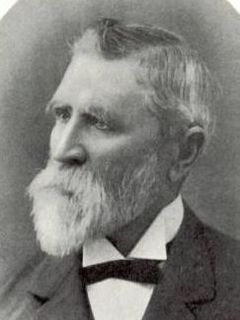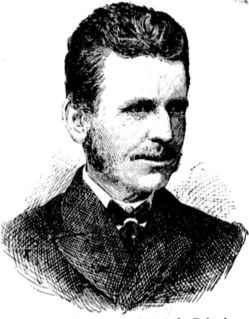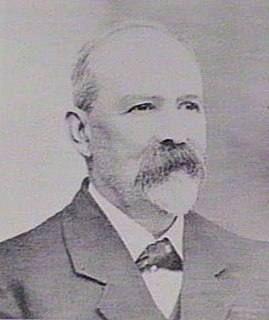Related Research Articles
Robert Scobie was an Australian politician, elected as a member of the New South Wales Legislative Assembly.

John Haynes was a parliamentarian in New South Wales, Australia for five months short of thirty years, and co-founder (1880), with J. F. Archibald, of The Bulletin.

Edmund Lonsdale was an Australian politician. Born in Morpeth, New South Wales, he was schooled in Maitland before becoming a bricklayer, builder and contractor. He was also an alderman on Armidale Shire Council.

Sir Albert John Gould, VD was an Australian politician and solicitor who served as the second president of the Australian Senate.
Arthur Griffith was an Australian politician. He was a member of the New South Wales Legislative Assembly from 1894 until 1917 and held a number of ministerial positions in the Government of New South Wales. He was a member of the Labor Party (ALP).

Alfred Edden was an Australian politician. He was a member of the New South Wales Parliament from 1891 until 1920 and held a number of ministerial positions in the Government of New South Wales. He was a foundation member of the Labor Party but left the party over the question of the solidarity pledge in 1891. He rejoined in 1895 and remained a member until the party split over the question of conscription during World War I. He then joined the Nationalist Party.
Electoral district of Alma, an electoral district of the Legislative Assembly in the Australian state of New South Wales, was created in 1894 and abolished in 1904.

John Stuart Hawthorne was an Australian politician.

Charles Alfred Lee was an Australian shopkeeper and conservative parliamentarian who served in the New South Wales Legislative Assembly for 35 years. Serving from 1884 for Tenterfield, he entered the Free Trade Party cabinet of George Reid in 1898 as Minister for Justice and briefly as Secretary for Public Works in 1899 until he returned to opposition in late 1899. Following Federation and the change of focus of the old party system in 1901, Lee was elected as the compromise leader of the new Liberal Reform Party and consequently the first official Leader of the Opposition. After leading the party to electoral defeat in 1901, he resigned owing to ill health in 1902. When the Liberal Reformers won office under Sir Joseph Carruthers in 1904, he was made Secretary for Public Works. He served with distinction, overseeing the expansion of rural infrastructure, under Carruthers and his successor Charles Wade, until the government lost office to the Labor Party in 1910. He thereafter served in the backbenches until his retirement to Tenterfield in 1920, where he died six years later.
Balmain North, an electoral district of the Legislative Assembly in the Australian state of New South Wales was created in 1894 and abolished in 1904.
Deniliquin, an electoral district of the Legislative Assembly in the Australian state of New South Wales was created in 1894 and abolished in 1913.
The Hastings and The Macleay, an electoral district of the Legislative Assembly in the Australian state of New South Wales was created in 1894 and abolished in 1920.
Sydney-King, an electoral district of the Legislative Assembly in the Australian state of New South Wales, was created in 1894 and abolished in 1904.
A by-election was held for the New South Wales Legislative Assembly electorate of Tenterfield on 14 September 1904 because Charles Lee had been appointed Secretary for Public Works in the Carruthers ministry. Until 1907, members appointed to a ministerial position were required to face a by-election. These were generally uncontested. On this occasion a poll was required in Bingara, Glebe and Tenterfield and all were comfortably re-elected. The four other ministers, Joseph Carruthers, James Ashton (Goulburn), Broughton O'Conor (Sherbrooke) and Charles Wade (Gordon), were re-elected unopposed.
The Richmond, an electoral district of the Legislative Assembly in the Australian state of New South Wales, was created in 1880 and abolished in 1913.
Rylstone, an electoral district of the Legislative Assembly in the Australian state of New South Wales was created in 1894 and abolished in 1904.
Sydney-Fitzroy, an electoral district of the Legislative Assembly in the Australian state of New South Wales, was created in 1894 and abolished in 1904.
Sydney-Lang, an electoral district of the Legislative Assembly in the Australian state of New South Wales, was created in 1894 and abolished in 1904.
Tenterfield, an electoral district of the Legislative Assembly in the Australian state of New South Wales, had two incarnations, from 1859 to 1920 and from 1927 to 1981.
Warringah, an electoral district of the Legislative Assembly in the Australian state of New South Wales was created in 1894 and abolished in 1904.
References
- ↑ "Mr Robert Pyers (1847-1915)". Former Members of the Parliament of New South Wales . Retrieved 16 June 2019.